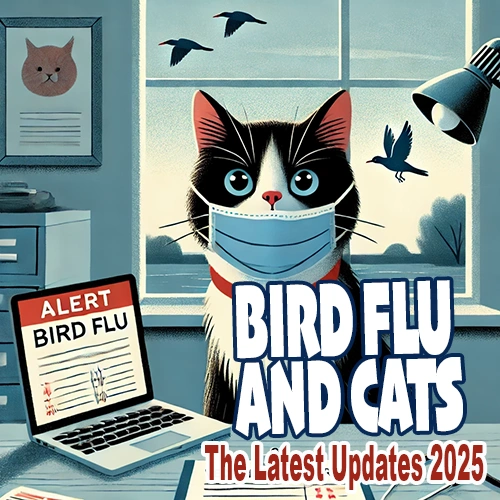
Bird Flu and Cats: What Pet Owners Need to Know in 2025
Table of Contents
If you’ve been following health news this year, you already know that bird flu is no longer just a concern for poultry. In 2025, bird flu in cats has emerged as a growing concern, with the highly pathogenic avian influenza (HPAI H5N1 virus) spreading in new and unexpected ways. As of January 2025, the U.S. has reported 85 confirmed cases in domestic cats across 15 states, with notable clusters in California (17 cases) and South Dakota (12 cases).
Even more concerning, the fatality rate for infected cats is estimated to be around 67%, according to the World Organisation for Animal Health (WOAH). While the numbers may sound alarming, understanding the risks and taking the right precautions can help keep your feline friend safe.
Why 2025 Is a Tipping Point for Bird Flu in Cats
This year, the H5N1 strain has evolved to infect mammals more efficiently than ever before. While seals, cows, and even foxes were affected by outbreaks in 2024, recent studies suggest that domestic cats are now among the most vulnerable species.
Unlike dogs or humans, cats have alpha-2,3 sialic acid receptors in their respiratory tracts—the same receptors that bird flu viruses use to infect birds. A 2025 study in the Journal of Veterinary Virology suggests that this unique trait makes cats particularly susceptible to infection, especially when exposed to contaminated environments or infected prey.
How Are Cats Getting Infected?
- Preying on sick birds – Even indoor-outdoor cats that catch a sick bird are at risk.
- Exposure on farms – Dairy farms with H5N1-infected cows have become hotspots.
- Raw food diets – Feeding uncooked poultry or eggs from infected flocks can transmit the virus.
- Contact with contaminated surfaces – Cats can be exposed through water bowls, soil, or bedding near infected birds.
A recent report from the CDC has also flagged indirect transmission, where farmworkers unintentionally bring the virus home on their clothing, leading to cases in house cats. While human-to-cat transmission is rare, it has been documented in isolated cases.
Symptoms in Cats: Spotting the Red Flags
The H5N1 virus progresses rapidly in felines, making early detection critical. Symptoms can appear mild at first but worsen within 24–48 hours.
Early Symptoms:
✔ Lethargy and loss of appetite
✔ Fever and sneezing
✔ Discharge from the eyes or nose
Severe Symptoms:
🚨 Respiratory distress (gasping, open-mouth breathing)
🚨 Neurological issues (head tilting, seizures, lack of coordination)
🚨 Paralysis or sudden collapse
In some cases, cats have died suddenly with no prior symptoms, making routine monitoring essential. If your cat shows any unusual signs, seek veterinary advice immediately.
🩺 Important: Never attempt to treat your pet at home without first consulting a veterinarian. Medications that work for humans (such as antivirals) may not be safe for cats.
How Bird Flu in Cats Compares to Other Pets
| Species | Infection Rate | Fatality Rate | Human Spread Risk | Preventive Measures |
|---|---|---|---|---|
| Cats | High | 67% | Low but possible | Keep cats indoors |
| Dogs | Rare (<10 cases) | 0% | None reported | Standard hygiene |
| Cows | Moderate | 10% | Low | Biosecurity measures |
| Birds | Very High | 90-100% | High (direct contact) | Culling infected flocks |
Source: CDC 2025 Avian Flu Report
While dogs rarely contract bird flu, cats appear to be significantly more vulnerable. Experts believe their natural hunting behavior and respiratory biology put them at a higher risk than other common pets.
Protecting Your Cat: 7 Non-Negotiables
1️⃣ Keep Cats Indoors
Letting cats roam outdoors is now riskier than ever. Consider enclosed catios or supervised leash walks as safer alternatives.
2️⃣ Ditch Raw Diets
H5N1 can survive freezing, so raw diets—even freeze-dried options—aren’t safe. Stick to cooked meals or high-quality cat food.
3️⃣ Bird-Proof Your Yard
Remove bird feeders, seal trash cans, and eliminate standing water to reduce the presence of wild birds near your home.
4️⃣ Shower & Change Clothes if You Work with Animals
Farmworkers and poultry handlers should change clothes and wash thoroughly before interacting with their pets.
5️⃣ Monitor for Symptoms & Act Fast
If your cat shows any signs of illness, contact your vet immediately. Early treatment could save their life.
6️⃣ Stay Updated on Vaccines
While no H5N1 cat vaccine exists yet, several companies have announced trials set for late 2025. Stay in touch with your vet for future updates.
7️⃣ Check Local Outbreaks
Use the CDC H5N1 Dashboard or WOAH Alerts to see if there are active outbreaks in your area.
Can Humans Catch Bird Flu From Cats?
While the CDC has confirmed two suspected cases of cat-to-human transmission in 2025, these involved prolonged exposure to respiratory secretions.
“This is not COVID,” says Dr. Amesh Adalja of Johns Hopkins University. “The risk of transmission from cats to humans remains low for the general population.”
Still, if your cat tests positive for bird flu:
✔ Isolate them in a separate room.
✔ Wear gloves and a mask when handling them.
✔ Ask your vet about antiviral medications if symptoms appear.
The Future of Bird Flu in Cats
🔬 Mutation Tracking – Global labs are monitoring new feline-specific mutations.
🏠 At-Home Test Kits – IDEXX is developing rapid swab tests for cat owners.
✈ Travel Restrictions – The EU now requires H5N1 testing for cats entering from affected areas.
Here’s a list of resource links used in this post for readers who want to stay updated on bird flu in cats and related research:
Bird Flu in Cats: Essential Resources & References
🔗 World Organisation for Animal Health (WOAH) – H5N1 Monitoring
Track global avian influenza outbreaks and the latest veterinary updates.
🔗 CDC 2025 Avian Influenza Report
Get the latest data on H5N1 transmission, affected species, and public health guidelines.
🔗 Cornell University – Bird Flu in Domestic Cats
Veterinary insights on how H5N1 is impacting feline health and what pet owners should know.
🔗 Johns Hopkins Center for Health Security – Mammalian Avian Flu Risks
Research on how H5N1 mutations affect mammals, including the latest findings on cat infections.
🔗 IDEXX Veterinary Diagnostics – Upcoming H5N1 Home Test Kits
Stay updated on developments in at-home flu testing for cats.
Final Thoughts
Bird flu in cats is a serious but manageable risk in 2025. The best way to protect your feline friend is through preventive care, staying informed, and acting quickly if symptoms appear.
🔹 Keep them indoors.
🔹 Avoid raw food diets.
🔹 Watch for signs of illness and consult a vet ASAP.
“Indoors is the new outdoors,” and raw diets aren’t worth the gamble. Stay vigilant, informed, and proactive to keep your pet safe.
Stay Updated:
📌 Bookmark the WOAH 2025 H5N1 Portal
📌 Follow local pet health alerts for updates.
Have questions or an experience to share? Drop a comment below—let’s work together to keep our cats and communities safe! 🐾
Loved this post? Explore more helpful cat care tips on our cat blog and join our community of cat lovers to share stories and advice!
Disclosure: This post contains affiliate links. If you purchase through these links, we may earn a commission at no extra cost to you.










